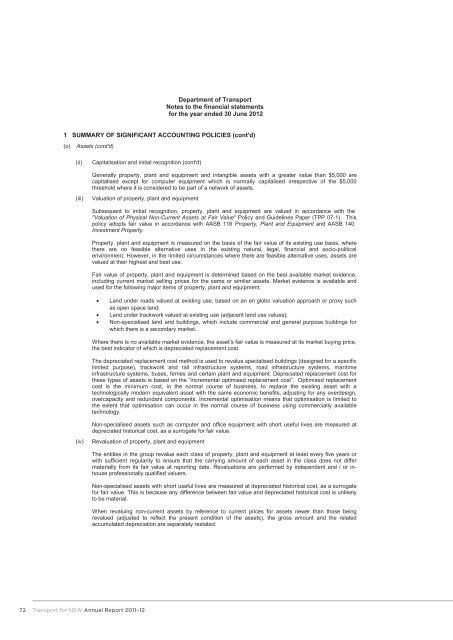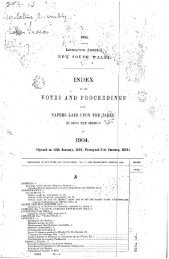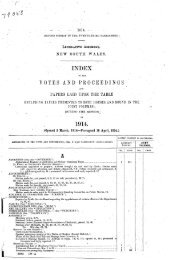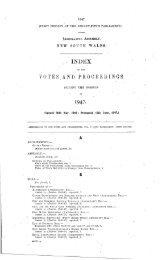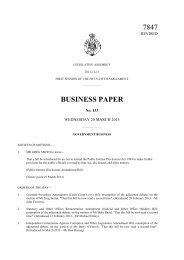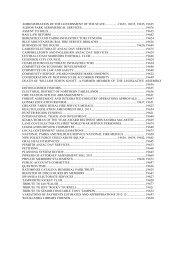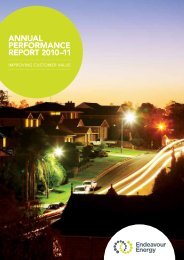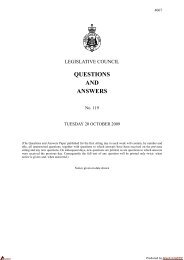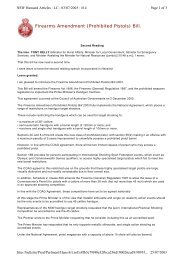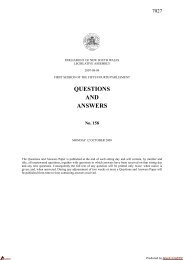annual report 2011â12 - Parliament of New South Wales - NSW ...
annual report 2011â12 - Parliament of New South Wales - NSW ...
annual report 2011â12 - Parliament of New South Wales - NSW ...
Create successful ePaper yourself
Turn your PDF publications into a flip-book with our unique Google optimized e-Paper software.
Department <strong>of</strong> Transport<br />
Notes to the financial statements<br />
for the year ended 30 June 2012<br />
1 SUMMARY OF SIGNIFICANT ACCOUNTING POLICIES (cont'd)<br />
(o)<br />
Assets (cont'd)<br />
(ii)<br />
Capitalisation and initial recognition (cont'd)<br />
Generally property, plant and equipment and intangible assets with a greater value than $5,000 are<br />
capitalised except for computer equipment which is normally capitalised irrespective <strong>of</strong> the $5,000<br />
threshold where it is considered to be part <strong>of</strong> a network <strong>of</strong> assets.<br />
(iii)<br />
Valuation <strong>of</strong> property, plant and equipment<br />
Subsequent to initial recognition, property, plant and equipment are valued in accordance with the<br />
''Valuation <strong>of</strong> Physical Non-Current Assets at Fair Value'' Policy and Guidelines Paper (TPP 07-1). This<br />
policy adopts fair value in accordance with AASB 116 Property, Plant and Equipment and AASB 140<br />
Investment Property.<br />
Property, plant and equipment is measured on the basis <strong>of</strong> the fair value <strong>of</strong> its existing use basis, where<br />
there are no feasible alternative uses in the existing natural, legal, financial and socio-political<br />
environment. However, in the limited circumstances where there are feasible alternative uses, assets are<br />
valued at their highest and best use.<br />
Fair value <strong>of</strong> property, plant and equipment is determined based on the best available market evidence,<br />
including current market selling prices for the same or similar assets. Market evidence is available and<br />
used for the following major items <strong>of</strong> property, plant and equipment:<br />
! Land under roads valued at existing use, based on an en globo valuation approach or proxy such<br />
as open space land;<br />
! Land under trackwork valued at existing use (adjacent land use values);<br />
! Non-specialised land and buildings, which include commercial and general purpose buildings for<br />
which there is a secondary market.<br />
Where there is no available market evidence, the asset’s fair value is measured at its market buying price,<br />
the best indicator <strong>of</strong> which is depreciated replacement cost.<br />
The depreciated replacement cost method is used to revalue specialised buildings (designed for a specific<br />
limited purpose), trackwork and rail infrastructure systems, road infrastructure systems, maritime<br />
infrastructure systems, buses, ferries and certain plant and equipment. Depreciated replacement cost for<br />
these types <strong>of</strong> assets is based on the “incremental optimised replacement cost”. Optimised replacement<br />
cost is the minimum cost, in the normal course <strong>of</strong> business, to replace the existing asset with a<br />
technologically modern equivalent asset with the same economic benefits, adjusting for any overdesign,<br />
overcapacity and redundant components. Incremental optimisation means that optimisation is limited to<br />
the extent that optimisation can occur in the normal course <strong>of</strong> business using commercially available<br />
technology.<br />
Non-specialised assets such as computer and <strong>of</strong>fice equipment with short useful lives are measured at<br />
depreciated historical cost, as a surrogate for fair value.<br />
(iv)<br />
Revaluation <strong>of</strong> property, plant and equipment<br />
The entities in the group revalue each class <strong>of</strong> property, plant and equipment at least every five years or<br />
with sufficient regularity to ensure that the carrying amount <strong>of</strong> each asset in the class does not differ<br />
materially from its fair value at <strong>report</strong>ing date. Revaluations are performed by independent and / or inhouse<br />
pr<strong>of</strong>essionally qualified valuers.<br />
Non-specialised assets with short useful lives are measured at depreciated historical cost, as a surrogate<br />
for fair value. This is because any difference between fair value and depreciated historical cost is unlikely<br />
to be material.<br />
When revaluing non-current assets by reference to current prices for assets newer than those being<br />
revalued (adjusted to reflect the present condition <strong>of</strong> the assets), the gross amount and the related<br />
accumulated depreciation are separately restated.<br />
72<br />
Transport for <strong>NSW</strong> Annual Report 2011–12


